If you have knowledge in HTML and the tech-savvy confidence to learn with video tutorials or studying related articles, then setting up Google Analytics through google tag manager plugins can be a piece of cake! On the other hand, if your technical skills need more refinement – don’t worry. With dedication and effort learning about HTML codes is achievable for any aspiring IT guru.
Google Tag Manager is a convenient tool designed to make marketing tag management effortless and straightforward. It allows users, even those without tech know-how or developers on staff, to quickly implement analytics tags across their website – making it easier than ever for social media promoters and sellers alike to optimize the performance of their digital presence.
Have you come across the term “Google Tag Manager” while browsing online? If so, you’re not alone. Many may be unsure of what it means and how to best utilize this powerful tool. Here’s a quick look into GTM – from its origins to the key information about how it works today.
With Google Tag Manager, the online world is at your fingertips. This powerful tool gives you access to a variety of website codes and tags that help improve its performance – like remarketing tags for advertisements, Adwords conversion scripts tracking user interactions with analytics events & more.
There might be some confusion between Google Tag Manager and Google Analytics. Given that these two are essential, they still have different purposes. Yet, when it comes to convenience, GTM always wins. GA needs to use various codes to run or update each event on a website.
Google Tag Manager modernizes marketing by allowing you to manage all of your tags in one place. No matter the number of events, Google Tag Manager ensures easy maintenance and streamlined performance on your webpage.
The Importance of Google Tag Manager Plugins
Making website tag management straightforward and reliable is possible with this one-stop plugin. Online marketers rave about its ease of use – but make sure you have a technical understanding beforehand to configure tags, triggers, and variables correctly.
Through google tag manager plugins, you gain access to valuable data about your website that can be customized according to your needs. Unlock insights into the performance of your site and make informed decisions regarding further optimization.
Depending on your tags, you might run your website faster than before.
Boost the performance of your WordPress site with one of the leading 5 Google Tag Manager Plugins enlisted below. Whether you’re looking to increase user engagement or reduce loading times, these plugins have something for everyone.
Ready to simplify your website tagging process?
Check out five of the highest-rated Google Tag Manager plugins and find an option that meets all your needs. Whether you’re looking for features, price point or user ratings – we’ve got them covered.
Best Google Tag Manager Plugins for WordPress
Need an easy way to manage tags on your website? Look no further! We’ve identified the top five Google Tag Manager plugins and alternatives, each with impressive features, ratings, and pricing. Unlock a world of effortless analytics integration today.
1. MonsterInsights
MonsterInsights is one of the invaluable google tag manager plugins for businesses, providing a comprehensive analytics solution that lets you track and analyze data. All without the need to rely on Google Tag Manage. Set up custom reports and gain essential insights into key performance metrics – MonsterInsights has it all.
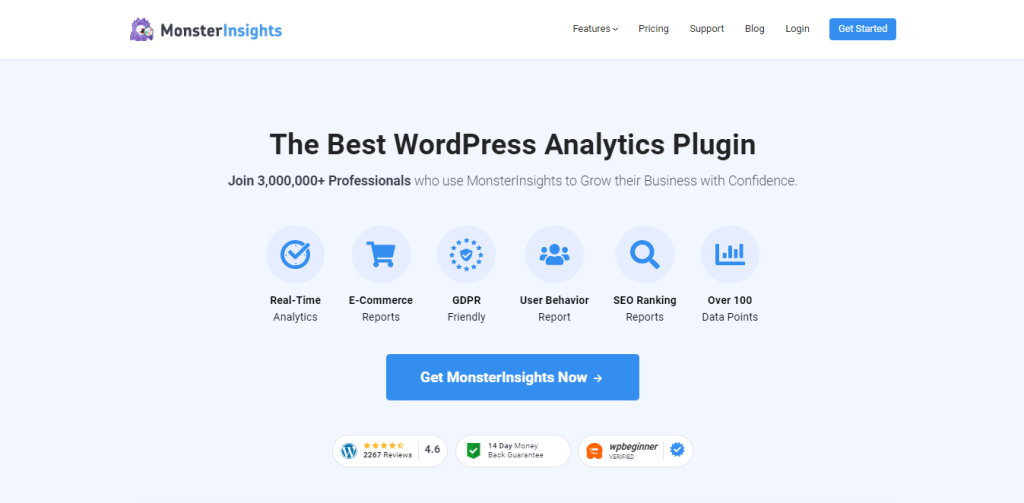
Make your WordPress site analytics easy and accessible with MonsterInsights! Get it up & running within minutes by setting up the quick setup wizard – just enter a few simple details about you and your business, then get connected to Google Analytics. With this powerful plugin installed, no need for long trips into the dashboard; see tracking results immediately in an intuitive format.
Features
Link and button click tracking
Unlock the power of real-time analytics on your website and optimize digital marketing results with effortless tracking of link & button clicks.
Form conversion tracking
With Google Tag Manager’s Form Add-On, you can easily monitor your form performance without the hassle of making tags manually. Get great insights into how well your forms are doing – all with a few clicks.

Track eCommerce performance in a few clicks
To stay on top of product performance, revenue tracking and conversion sources metrics with ease – simply install the plugin addon. Adding it to your Google Analytics system will ensure you have an up-to-date look at all the key information that affects your business.
Pricing
Like many other Google Tag Manager plugins, MonsterInsights has three pricing plans to choose from, each offering different features and benefits. The Basic plan is free and allows users to track up to 500 events per month with key metrics like page views and session duration. The Plus plan costs $9.99/month and offers unlimited events supported by MonsterInsights Advanced Features. The Pro plan costs $29.99/month and includes advanced customization along with the Plus plan’s features. All plans include a 14-day free trial so customers can use the plugin before committing to it long term.
For more pricing details, click here.
Drawbacks
- With the free version, you’ll have access to basic tools and features – but if you want more of a comprehensive experience with maximum resources, investing in an upgraded plan may be worth considering.
- The Premium plan costs more than its alternatives.
2. Site Kit by Google
Site Kit is among the extremely useful google tag manager plugins to take your WordPress site to the next level. With this comprehensive tool, you can gain vital insights into how visitors are interacting with your site — and equip yourself for success. Connect to multiple products from Google’s suite of options and make data-driven decisions that optimally serve those landing on your page.
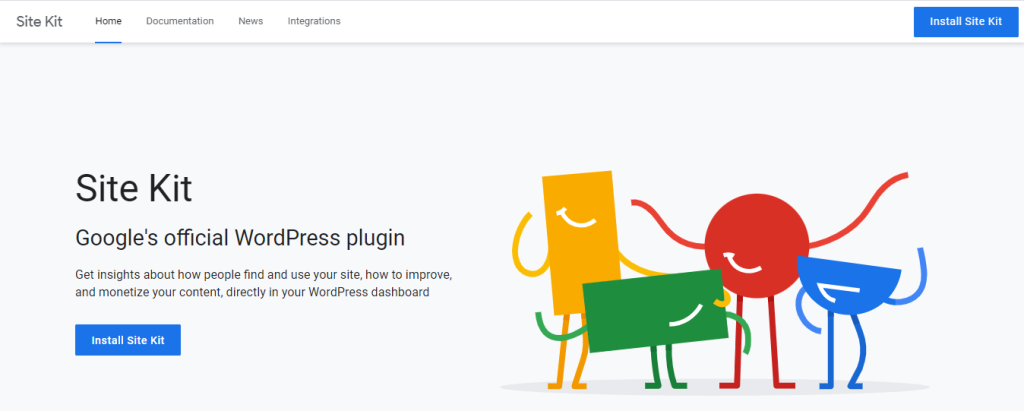
Site Kit makes building websites easy for even the most novice users. An official and free plugin, Site Kit’s intuitive interface gives everyone access to powerful tools right at their fingertips.
With Site Kit, you can quickly and effortlessly get your website running in just three steps- all that’s needed is to sign into a Google account. To take it one step further, connecting up with the powerful tool of Google Analytics during setup is also an option.
To take control of your website tags and make the most out of them, access your WordPress admin page to head straight into Site Kit’s Settings menu. From there choose Connect More Services and click Set up Tag Manager – this will ensure you’re able to configure any tags quickly and easily.
Site Kit -> Settings -> Connect More Services -> Set up Tag Manager
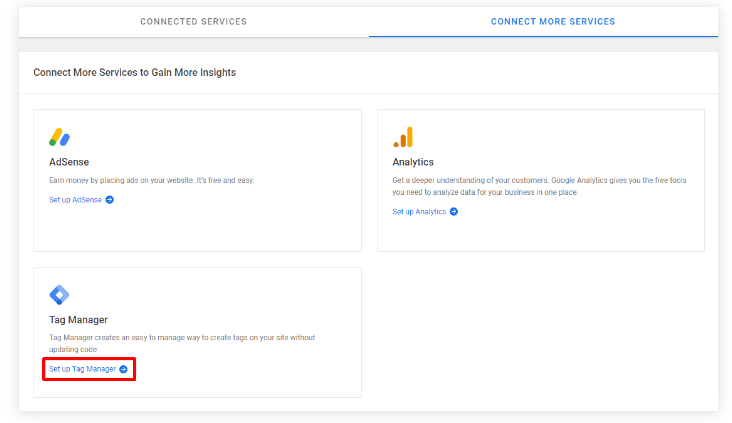
Ready to take your setup to the next step? Select a Tag Manager account and container, then click Confirm & Continue to complete it.
Features
The best Google tools on WordPress
With your Google account, you can easily keep up with the latest trends and analyze user behavior. Collect valuable data from Analytics, Search Console, AdSense & Tag Manager – all without any code editing required.
Stats for the whole site and every page
Get direct advice from Google on your WordPress dashboard and maximize the potential of your content. With Optimize, you can perform A/B testing to guarantee effective results.
PageSpeed Insights
Take your website to the next level by benchmarking it against similar websites and getting actionable tips on how you can improve its performance.
To download, click here.
Pricing
Unlike other Google Tag Manager Plugins, Site Kit has four different pricing plans to choose from, each offering different features and benefits. The Basic plan is free and allows users to track up to 500 events per month with key metrics like page views and session duration. The Plus plan costs $9.99/month and offers unlimited events supported by Site Kit Advanced Features. The Pro plan costs $29.99/month and includes advanced customization along with the Plus plan’s features. All plans include a 14-day free trial so customers can use the plugin before committing to it long term.
Drawbacks
- In comparison to other google tag manager plugins offering specific functionality, it tends to be less detailed.
- When you connect to Google services, the configuration process puts your settings into two distinct categories only: “enable” or “disable.” You get limited control over how these features are used.
3. Google Tag Manager for WordPress (GTM4WP)
Utilize the power of open-source with GTM4WP and make sure your code snippets will be correctly implemented on your website for maximum effect. With enhanced eCommerce tracking, Google Optimize support, you can utilize code modifications to <head> and <body> tags easily from one single point.
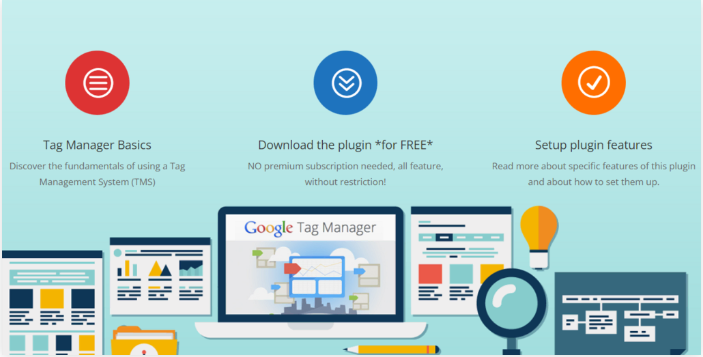
Distinguishing itself from other google tag manager plugins, it’s possible to enrich your data layer with useful information with GTM4WP, allowing for extra features in tags. Your events and variables are constantly traversing the layer – you can even configure triggers dependent on variable values.
To start using the plugin, head over to your Settings menu and select Google Tag Manager. Input your GTM container ID in the General tab to begin configuration of code placement – then don’t forget to click ‘Save changes‘.
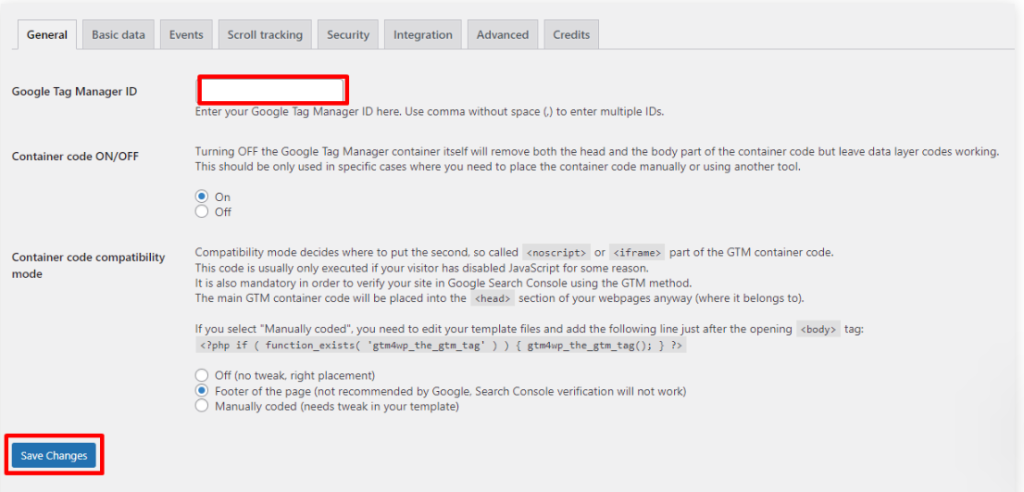
Features
Media player events
With GTM4WP’s Media Events feature, you can track how visitors interact with videos from YouTube, Vimeo and Soundcloud. Unlock insights about viewers’ preferences to enhance their experience – enabling seamless sharing for musicians everywhere.
Scroll tracking
Follow your customers’ actions by tracking their scrolling behavior and engaging with them in real-time using dedicated tags. Anticipate user needs, spark curiosity, and provide a tailored experience to make each visit unique.
To download, click here.
Pricing
Similar to other Google tag manger plugins, Google Tag Manager for WordPress (GTM4WP) also offers three pricing plans: a free plan, Lite Plan ($5/mo), and Advanced Plan ($15/mo). The free plan provides basic tag management features including embedding tags and variable definitions. The Lite plan adds advanced features such as automatic tag firing and integration with other services or third-party data sources. And the Advanced plan includes all of the Lite plan’s features plus additional developer tools such as segmentation capability and custom triggers.
Drawbacks
- Need to have a good understanding of how to properly configure and deploy tags
- Costs associated with certain features – can be quite expensive compared to other solutions, may need to use additional plugins or services in order to track more advanced metrics or customize the tagging setup.
4. Header Footer Code Manager
Make your website stand out with Header Footer Code Manager (HFCM), a powerful and easy-to-use WordPress plugin. Differentiating itself from other google tag manager plugins, it allows you to inject custom code into the header, footer, or content of your site quickly and without altering its theme – great for adding tracking codes, pixel scripts & more. Take control of how users interact on your webpage today.

With HFCM, take the hassle out of managing multiple snippets. It can handle it all for you with a simple toggle – just flick on to activate your code and off again whenever needed. Plus, access an intuitive user-interface plus custom device support – whether mobile or desktop (or both!), your scripts will load effortlessly every time.
Gain control of your website’s head and footer sections with HFCM. To get started, simply navigate to the Add New option in its sidebar. Creating two separate snippets is all you need –no coding required– so customize away and make sure each page sets up a great first impression.
HFCM -> Add
With just a few clicks, you can get your Google Tag Manager snippet up and running. Give it an identifiable name – like “Google Tag Manager Header” – select the desired location (Header), paste in your code snippets, and save. You’ll be on track to collect valuable data quickly & easily.

Prompt another snippet for the Footer section. For instance lets call it “Google Tag Manager Footer.” – select the desired location (Header), paste in your code snippets, and save.

Features
Snippet targeting
Scripts can be strategically targeted or excluded to provide a streamlined, efficient user experience. This helps prevent excess code from bogging down pages and posts as well as taxonomies and archives.
Manage a large number of scripts
To maximize efficiency, be sure to classify each snippet with a relevant title – this will make it easier for you to quickly recall their intended purpose.
HFCM shortcodes
Instead of manually adding code snippets to your WordPress theme each time, you can use shortcodes for a convenient and easy way to monitor, edit, or manage multiple codes. Now managing customizations with WP is as effortless as possible.
Variety of script types
With supported snippets and pixels such as those from Marketing/CRM, Facebook pixel, and Google Analytics, you’ll be well on your way to optimizing digital marketing strategies for success.
To download, click here.
Pricing
HFCM has a free version and three paid plans similar to many other google tag manager plugins:
– Basic plan costs $15/month. It includes 5 sites and up to 3 customizations.
– Pro plan costs $35/month. It includes 15 sites and up to 8 customizations.
– Enterprise plan costs $85/month. It includes unlimited sites and unlimited customizations.
Drawbacks
- HFCM requires a complicated installation process and understanding of coding concepts in order to properly use it.
- HFCM runs on a server, which can result in slow loading times for users accessing the code from their computers.
- Some advanced features, such as the unlimited number of scripts, shortcodes, and body tag snippets, are only available in the premium version.
5. Tag Manager – Header, Body, and Footer
Tag Manager by YYDevelopment offers a quick and easy way to customize your WordPress website. Incorporate tracking codes from Google Tag Manager plugins, Google Analytics, or Facebook Pixel in moments with its free plugin. Plus – add meta tags into the head section of your site effortlessly using custom HTML footer code injection below and above the closing <body> tag.

With only a few simple clicks, this plugin will quickly be up and running on your site and this is what makes it stand out among the leading google tag manager plugins. To get started, just download the software and activate it in Tag Manager via your sidebar. Then all you need to do is paste in the code from Google – easy as that.
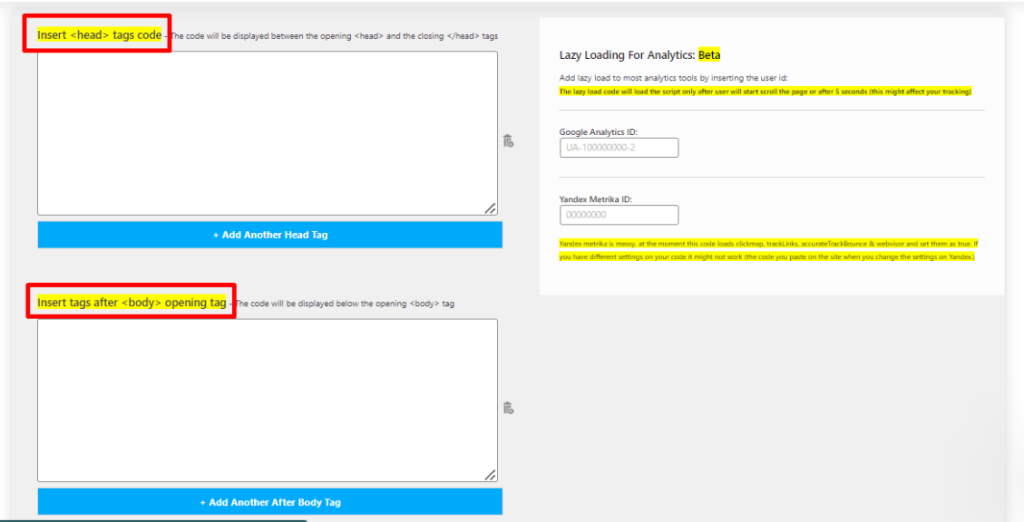
Features
Injection location and feature
Tag Manager plugin unlocks the opportunity to customize your WordPress site by giving you full control over code snippets added to its head, body, and footer sections. Plus – never worry about being limited in adding multiple codes at each part.
Exclude code from users
Keep your code safe and sound. Easily exclude specific users from accessing sensitive information with our advanced security measures. Now, you can securely share access without risking a data breach.
Google and other platforms are supported
Easily integrate your business with the most popular online resources, no matter what type of website you’re running. From Google’s key products to social media platforms and much more – this solution makes connecting simple.
To download, click here.
Pricing
Tag Manager – Header, Body, and Footer is a subscription-based service with plans based on the amount of data tracked. Prices begin at $9/month for up to 2 million monthly page views and increase depending on the number of page views tracked per month. Additional features such as advanced tagging and custom variables are also available with some plans for an extra fee. Its therefore an economical choice in comparison to other google tag manager plugins.
Drawbacks
- If you’re running a large business, Tag Manager might not be the best choice for your needs. With more complex operations come advanced features that may require an alternative solution to ensure optimal performance.
- Tag Manager does not allow users to fine tune when specific tags are fired, leading to potentially wasted resources on unwanted traffic or inaccurate data collection.
Conclusion
Google Tag Manager is a powerful tool that can help you take your WordPress site to the next level. The five plugins we’ve listed above are some of the best options available and should be able to meet the needs of most sites. If you’re not sure which plugin is right for you, take some time to read through each one’s features and decide based on your specific needs.
And don’t forget – once you have a plugin installed, make sure to test it out thoroughly before going live with it on your site. We hope this article has helped you learn more about Google Tag Manager and how it can benefit your website.
What other questions do you have about using Google Tag Manager on WordPress? Let us know in the comments below!
